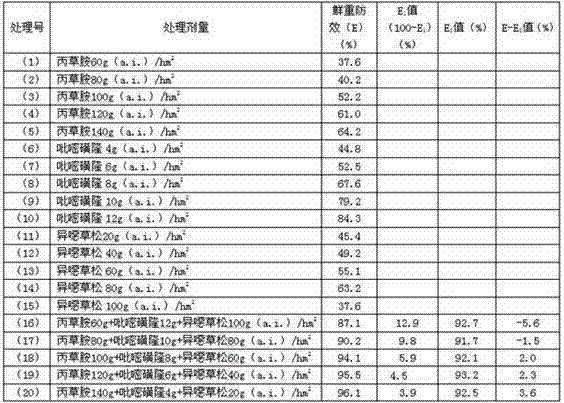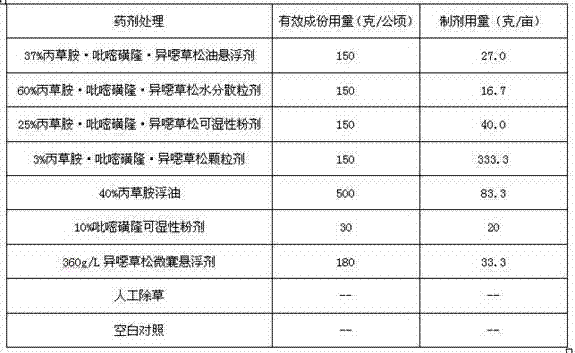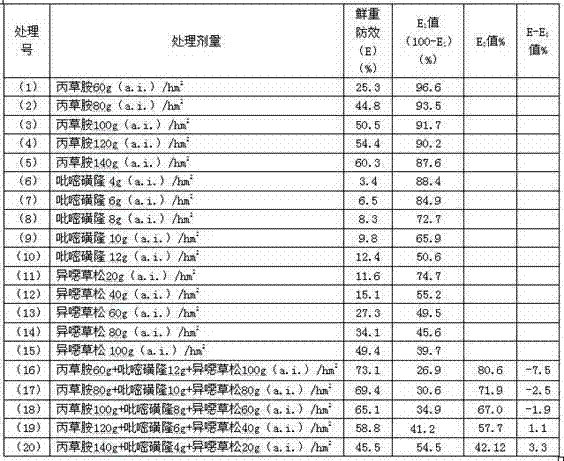Weeding composition for rice direct-seeding field
A herbicidal composition and the technology of the composition, applied in the field of herbicidal compositions for direct-seeding rice fields, can solve problems such as the control effect of weed resistance in farmland, and achieve the effect of rapidly exerting drug effects, reducing adverse effects, and reducing the dosage
- Summary
- Abstract
- Description
- Claims
- Application Information
AI Technical Summary
Problems solved by technology
Method used
Image
Examples
Embodiment 2
[0025] Preparation Example 2: 60% pretilachlor · pyrazosulfuron · clomazone water dispersible granules.
[0026] Pretilachlor 28%, Pyrazosulfuron-methyl 4%, Clomazone 28%, Sodium Lauryl Sulfate 4%,
[0027] Carboxylate 5%, urea 10%, add kaolin to 100%.
[0028] Put the above materials together into the conical mixer and mix evenly, and then pulverize through the jet mill, and then mix the pulverized materials through the conical mixer. Knead into a plastic material, and finally put the material into an extrusion granulator to extrude and granulate. After granulation, dry and sieve to obtain 60% pretilachlor·pyrazosulfuron·clomazone water dispersion granules.
[0029] Preparation Example 3: 38% pretilachlor · pyrazosulfuron · clomazone wettable powder.
[0030] Pretilachlor 10%, pyrazosulfuron-methyl 2%, clomazone 26%, sodium lauryl sulfate 2%,
[0031] Sodium butyl naphthalene sulfonate 3%, calcium lignosulfonate 5%, silica 5%, kaolin to 100%.
[0032] Put the above m...
Embodiment 4
[0033] Formulation Example 4 : 3% pretilachlor · pyrazosulfuron · clomazone granules.
[0034] Pretilachlor 1.0%, pyrazosulfuron 0.1%, clomazone 1.9%, sodium lauryl sulfate 4%, calcium lignosulfonate 5%, attapulgite 30%, add kaolin to 100%.
[0035] Put the above materials together into the conical mixer and mix evenly, and then pulverize through the jet mill, and then mix the pulverized materials through the conical mixer. powder. Put this wettable powder into a disc granulator, add water to granulate, and then dry in a drying cylinder, sieve, and cool in a cooling cylinder to obtain 3% pretilachlor-pyrazosulfuron-clomazone granules.
[0036] Biological Assay Example 1.
[0037] In order to verify the present invention, we carried out the toxicity test of pretilachlor, pyrazosulfuron-methyl, and clomazone on barnyardgrass and bermudagrass.
[0038] 1 Materials and methods.
[0039] 1.1 The test drugs: pretilachlor 94% original drug; pyrazosulfuron-etyl 97% original dr...
Embodiment 2
[0061] Biological Assay Example 2: Drug efficacy test for controlling annual weeds in direct-seeded rice field.
[0062] 1 Test conditions.
[0063] 1.1 Crops and cultivars: Rice (variety: Wanjinyou 133).
[0064] 1.2 Selection of test subject weeds.
[0065] The dominant weeds in the field mainly include: Barnyardgrass [Echinochloa crusgalli], Qianjinzi [Leptochloa chinensis], Alopecurus aequalis [Alopecurus aequalis], Cocklegrass [Monochoria vaginglis], Cyperus rotundus, etc.
[0066] 1.3 Cultivation conditions.
[0067] The test site is located in Yanwanghu Village, Yanwanghu Town, Hanshou County, Changde City, Hunan Province. Rice is planted all year round, and rice and rape are rotated. The rice for testing was sown on April 13, 2011, with a sowing rate of 2 kg / mu. The rice seeds were germinated until the breasts were broken and white, and 15 kg of compound fertilizer per mu was used as base fertilizer. The conditions of rice variety, sowing time, growth and fertili...
PUM
 Login to View More
Login to View More Abstract
Description
Claims
Application Information
 Login to View More
Login to View More - R&D
- Intellectual Property
- Life Sciences
- Materials
- Tech Scout
- Unparalleled Data Quality
- Higher Quality Content
- 60% Fewer Hallucinations
Browse by: Latest US Patents, China's latest patents, Technical Efficacy Thesaurus, Application Domain, Technology Topic, Popular Technical Reports.
© 2025 PatSnap. All rights reserved.Legal|Privacy policy|Modern Slavery Act Transparency Statement|Sitemap|About US| Contact US: help@patsnap.com



